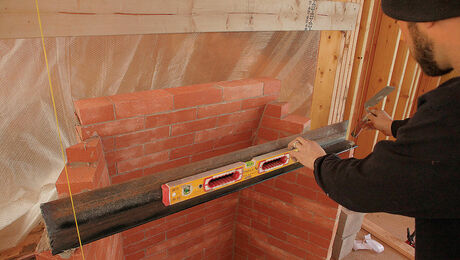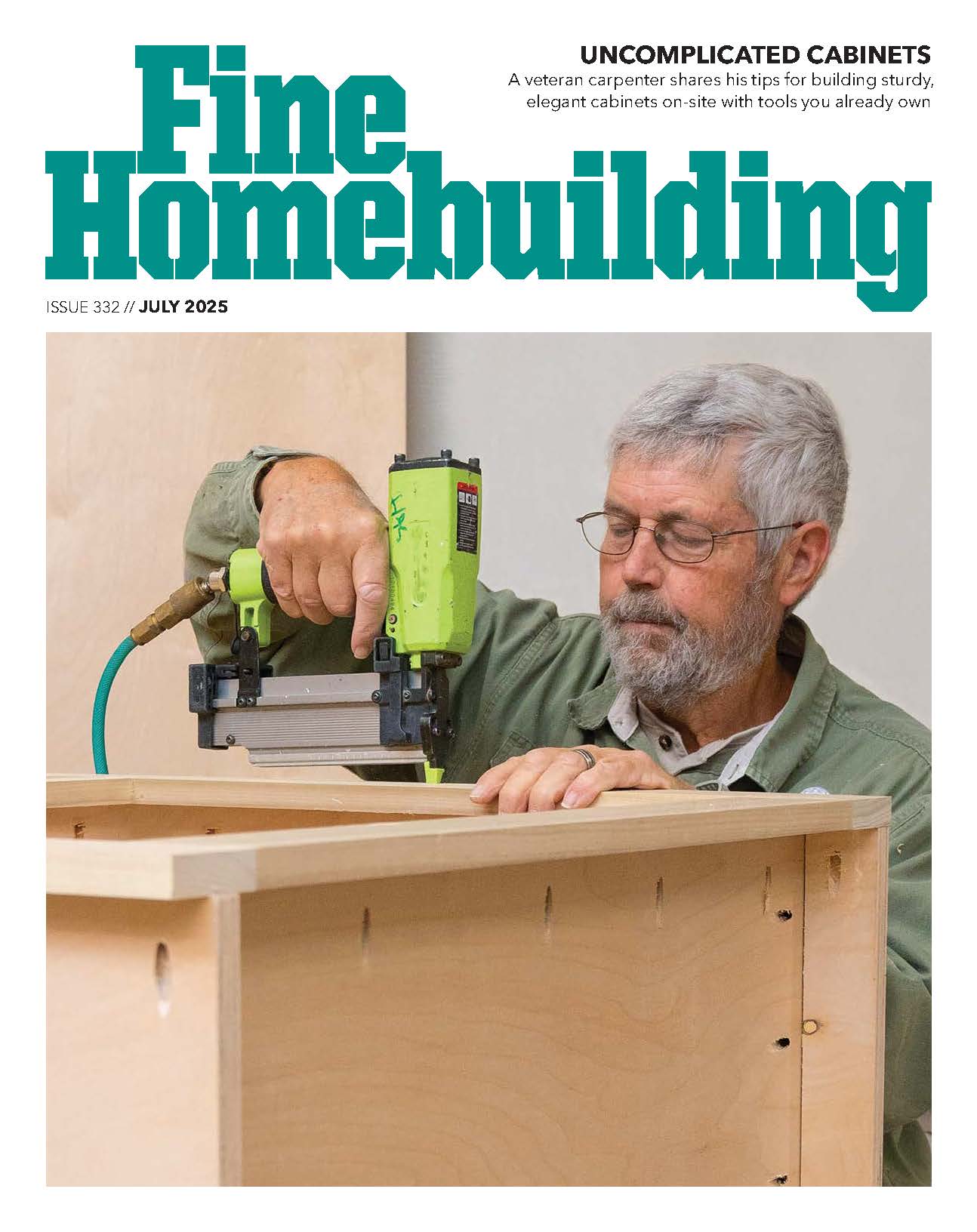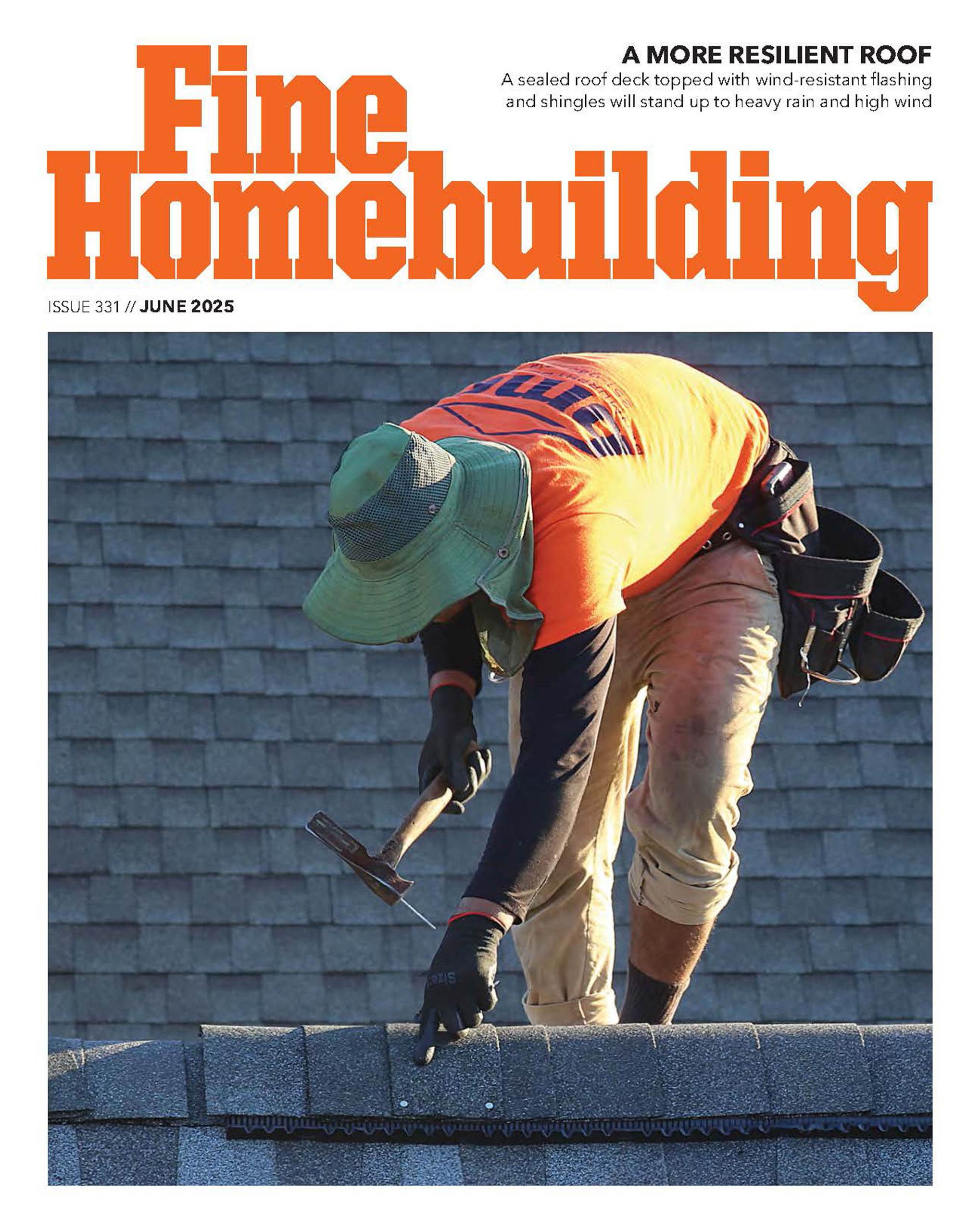I thought it was a good idea to support a wire nut connection by wrapping it with electrical tape. The inspector recently suggested I not do it. The reason given is that if a connection is loose, the tape may hold it together just enough to keep the wires close enough together to spark. If the tape were not there, the connection would more likely come loose, calling attention to the problem.
Comments???
Thanks,
Paul




















Replies
I've had years of conflicting advice on this, and I know of no code rules on it. I expect it falls in the nebulous category of ‘good workmanship’. I had one inspector insist that all wire nuts be wrapped with tape, and another that was utterly contemptuous of the idea. This really sucks. Lately I've always raised the issue in the first meeting with the inspector so that I know what they expect.
My latest strategy, which I think is a good one, is to tape all splices that involve stranded wire, including stranded to stranded, and stranded to solid. In my experience stranded wire can cause splices to pop. I extend the stranded wire about 1/8" above the solid before cranking the nut on, then tape. It seems to work well.
Good luck,
Scott.
Always remember those first immortal words that Adam said to Eve, “You’d better stand back, I don’t know how big this thing’s going to get.”
I twist the conductors together to start with. Then use a wire nut. Then tape the nut.
I wouldn't advise depending on just the nut to hold the wires together.
But I didn't answer your question did I.
While I understand your inspector's argument, I disagree. If the conductors were not twisted together to start with, and it's just the nut holding the wires together? the nut comes loose, falls off, now you have unprotected hot conductors in the box.
If the nut were to come loose and the wires became separated, the circuit would still be intermittent. But the tape would at least hold the nut to shield the conductors.
You want an intermittent light or outlet to let you know that the conductors came loose. Not smoke and fire.
Redundancy? Hell, I fly jets. I want three hydrualic systems and a back-up flight control system. I'll know when it's broke, I just want to survive the break so I can get the machine fixed.
Mongo
>> I fly jets. <<
Hummm... That doesn't sound like something you do for a hobby?
Matt, a little of each.I fly one type of jet for a lot of fun and a little pay, the other for a little fun and well...a little pay.
Mongo,
Are there any threads here about the jets you fly?
Not in recent years.We had a few "get to know me" threads where we posted about what we do and what we've done way back in the early daze of Breaktime, back in the '96-'97 time frame. But no, in recent years I've never really gotten into it on these forums. I think Stan pretty much has a lock on the aviation threads with the whirlygig thing he flies.I never opted in on the Tavern when it changed over to private ownership, so I miss out of the off-topic threads that go on behind those closed doors.
I never opted in on the Tavern when it changed over to private ownership
Yeah, I've stayed out of the Tavern since then, too. I waste enough time here as it is! ;)
I'm curious about the planes you fly though. Can you briefly tell me what they are?
Sorry for the ate reply. I never saw this as an unread message until today.In the USAF I flew T-37s and T-38s in training, and A-10s and F-16s.Got out after the '91 Gulf War.Commercially I've flown B-727s, B-757s, B-767s, L-1011s, and MD-88s.When I was in the USAF I was an A-10 demo pilot for air shows. After getting out I flew a privately owned T-38 in air shows.Mongo
about the only time I use tape anymore,
is when I'm making up ..small... motors, the tape is fiberglass though
other than that it depends on the installer and the wirenuts , the old hard plastic nuts always seemed to be too short to cover the splice ,
some of the nuts with the wings on them take up more room in the boxes, but tend to be long enough to cover the bare wire
3M makes some that are two sizes in one ..those are really big but they have a large "skirt"
I picked up some Ideal "filled " wirenuts the other day and the package instructions suggests a small twist before using one, but no mention of tape
my personal favorite has always been the Buchanan crimped sleeves..especially outside, it makes the splice permanent !
so they would have to be cut open if you ever rework that circuit
.
.
.
, wer ist jetzt der Idiot ?
I dunno. I've never come across an electrician who tapes wirenut connections for general installations, and no electrician I ever worked for had me do it. So when I see taped connections (other than on some factory-wired equipment), my thought is that it was not done by a pro.
When I take them apart, usually there is bare copper exposed outside of the wirenut and somebody added tape to cover it up. Shoddy.
FWIW...............Ed
Friend who is an electrician says the same thing. If he sees taped wirenuts he figures the homeowner did it.Bear
Code says to install wire nuts according to manufacturers' directions. The directions don't say to tape.
Taping makes servicing and changes more difficult. I don't tape.
Paul:
It's an accurate observation that the vast majority of professional electricians don't tape. That doesn't mean it's not a good idea -- just that the pros don't think it's worth their time.
I've seen installations in which wires have worked their way out of the wire nuts. On a few, this led to arcing, and some black marks were visible within the box. For that reason, I taped when I first learned how to do electrical work (I'm a contractor, though, not an electrician).
Since that time, however, I've come to the conclusion that the wire nut failures I've seen are more due to faulty installation than to an inherent design problem associated with wire nuts.
What I do now is make sure that I keep twisting the wire nuts on until the 2" or so of wires leading up to the nut start to neatly twist around each other. In this manner, the wires are bound together and the chance of a single wire working its way out of the nut is almost nil.
The other thing I do is try to locate the wire nuts in opposite corners in the box. In that way, there's less chance of them coming into contact with each other. This isn't always possible, of course, but I do it when it is, and it doesn't take any extra time.
The only time I'll still tape is when working with multi-stranded wire; for whatever reason, it doesn't seem to work as well as solid when it comes to wire nuts.
PS: I think the inspector's reasoning leaves something to be desired. ;)
Edited 6/10/2007 2:49 pm ET by Ragnar17
I have always taped wire nuts. Admittedly, I'm a DIY'er, not a contractor. I think it's more of an asset than a liability to tape the nuts and will continue the practice. I find the inspector's reasoning to be faulty. The best practice would be the one that minimizes the risk of wire movement to begin with.
My two cents..New knowledge is priceless.
Used knowledge is even more valuable.
I find the inspector's reasoning to be faulty. The best practice would be the one that minimizes the risk of wire movement to begin with.
I agree with you on both counts.
Taking it further...Twist the bare copper together before putting on the nut.Apply the nut. Keep twisting until the wires twist together further down.Tape. (Looking at the top of the wirenut, with the wires on the end opposite where you are, apply the tape clockwise. This opposes the direction the nut would have to turn, to come off.)Now apply one nylon wire tie. About 1/4" down from the nut. Cinch that sucker as tight as you can get it and cut off the excess.(Put more tape around the cut off wire tie, if you are concerned about it cutting someone or something.)IMO When it comes to electrical work, overkill should be standard. And is definately preferable to the 'kill' that may happen otherwise.And yes... I do all the above when wiring inside a motor or other environment where I think there is going to be any constant vibration. Yes, all of it. I didn't just add something because I read it here.I have done this inside outlet boxes as well. Generally I am satisifed there with everything but the nylon wire ties. Except when someone has cut the wires so short that it has been difficult to make the splice. I don't wanna go back and do that one again... LOLAnd recently I went to the crimped sleeves when I installed some baseboard heaters. I musta put a whole roll of tape on just 6 of those connections. LOL Something about all that bare copper giving me the heebies before I started taping.;o)Ok, so I get a bit OC when it comes to splices. Just putting the wirenut on correctly may be enough. But in my OC mind, when standing there doing the job, 'enough'... Is NOT.So sue me.
Fight fire with water.
Oh, and I twisted the wires together for about half their available length, when I did the crimps, too.
Fight fire with water.
Why all that? Why don't you just do it right and solder them?
Ed
ROFLOLSee Junkhound's response.I've alwys heard that soldered connections are less reliable.
Fight fire with water.
.." And recently I went to the crimped sleeves when I installed some baseboard heaters. I musta put a whole roll of tape on just 6 of those connections. LOL "Jeff, there are a few different caps for those sleeves , one type is reuseable while the others snap on and have to be cut off http://www.idealindustries.com/wt/CrimpConnectors.nsfsince Ideal bought Buchanan , their copper sleeves are listed as well, including the 4-way crimperbtw, these are the ones I mentioned in my earlier post.
.
.
., wer ist jetzt der Idiot ?
Thank you.
Fight fire with water.
>>> I musta put a whole roll of tape on just 6 of those connections.
You forgot the final coat of liquid tape (comes in 4 oz can with screw-top brush).
Make sure you slather plenty of the stuff on top of the final tape that covered the plastic strap, that held the previous tape, that covered the wirenut, that held together the bare conductors. Can't be too cautious with them loose electrons.
;>)
Nah, I'll just use JBWeld or fiberglass gel to encase the whole lot down in the back of the box.;o)I wonder how far we can take this ?=0)
Fight fire with water.
I tape, and color code the tape. Black for hot; Red for switched; White for Neutral. Orange or Blue for a traveler wire in a 3 way switch. I agree that it makes servicing the box a bigger deal. Oh well.Regards, Scooter"I may be drunk, but you're crazy, and I'll be sober tomorrow." WC Fields, "Its a Gift" 1934
I tape...oh my God I admitted it!
When spliced in a metal box and especially on dishwashers where there is a lot of vibration and movement and a metal box.
Our electrician does same. He also wraps the outlets in the backslash for us so the tile guy doesn't get fired up.[email protected]
I also slowly twist the wires as you say; and also place in opposite corners if possible. Yes, I also wear belt and suspenders.
One caution: Be sure NOT to twist too hard. I did this and one of the wires broke just outside the cap spring and not noticable until taking off the cap. Could not figure out why my table saw would not work; checked everything twice and then found the break.
After twisting wires inside the cap; I also pull on each wire to be sure it is fully captured, and complete
>> It's an accurate observation that the vast majority of professional electricians don't tape. That doesn't mean it's not a good idea -- just that the pros don't think it's worth their time. <<
And as Luka says, they twist the wire nut until it twist the involved wires together down the insulation too in addition to the fact that they already twisted the bare conductors together with their pliers. One additional point is that what I see is they use their Clines (electrician pliers) to twist the wire nuts on tight.
I tape but here, in NC I am not allowed to do any electrical work (at work) since I don't have an electricians license, nor do I work for an electrician. They pretty have it set up so you really can't get the license unless you do a multi year apprentiship. Sure, I could wing it on a few things, but if there was ever a prob I'm sure the first thing that would happen would be that I would loose my GC license. So, in 99% of the situations I have my electricians do whatever.
Klein.
http://www.kleintools.com/
I agree with Matt. Most Electricians I've seen use pliers to twist the conductors first, then trim the ends to equal lengths. They use pliers to secure the nut and twist the insulated wires.
If you do all that right, what's the tape for? The only time I use tape is to label wires, or occasionally to hold wires on overhead fixtures together while I am hanging them.
Dont use wire nuts, twist and crimp. I use the ideal crimps with the rubber boot over them.
In own house, even soldered the crimps -- even though mil-std-217 says a soldered crimp is less reliable than a crimp. That however, is due to often poor workmanship on soldering or mistaken use of acid flux; mine soldering is always perfection however <G>.
The only time I've been told to use black phase tape with wire nuts is in motors. Other than that, seeing tape on wire nuts is a sure sign of do it yourselfer at work.
I pretwist solid wire with linemans pliers. For stranded, it doesn't seem to matter except that it seems to help hold the wires together until I can get the cap on.
One post brought up the electrician who insisted on stranded wire. It may be easier to pull but is harder to push. But more importantly, it is harder to make the connections to the receptacle screws. The little strands tend to mush out.
Note: I do wrap tape around the receptacles. Tape should be rated for 600 volts.
~Peter
when you say you wrap tape around receptacles, are you meaning you wrap it around the entire device, such that one continuous wrap will cover the screw heads and bare copper from the wires? I do this on outlets as well as switches. be it for tile guys or whomever, it helps prevent someone getting lit up if they *accidentally* poke into the box with a conductor - screwdrivers being the most guilty conductor
I not an Electrician but I play on on TV. at work we tape all motor connection 1/4 hp to 300hp IE 480 v 3 phs. general lighting and outlets no tape just twist the wire until it has 3-4 turns below the wire nut. we do tape the side of all outlets and switches and I just put on an addition on the house inspector said to tape all outlets amd switches but nothing about splices. I have seen motor splices that have vibrated the wire nut right off the wire with out tape
ps chemical plant we make glue
Wire nut instructions do not say to use tape. Using tape may be a violation of the listing.
I doubt that, if it said "not to tape" then it would be wrong. Just my opinion though.